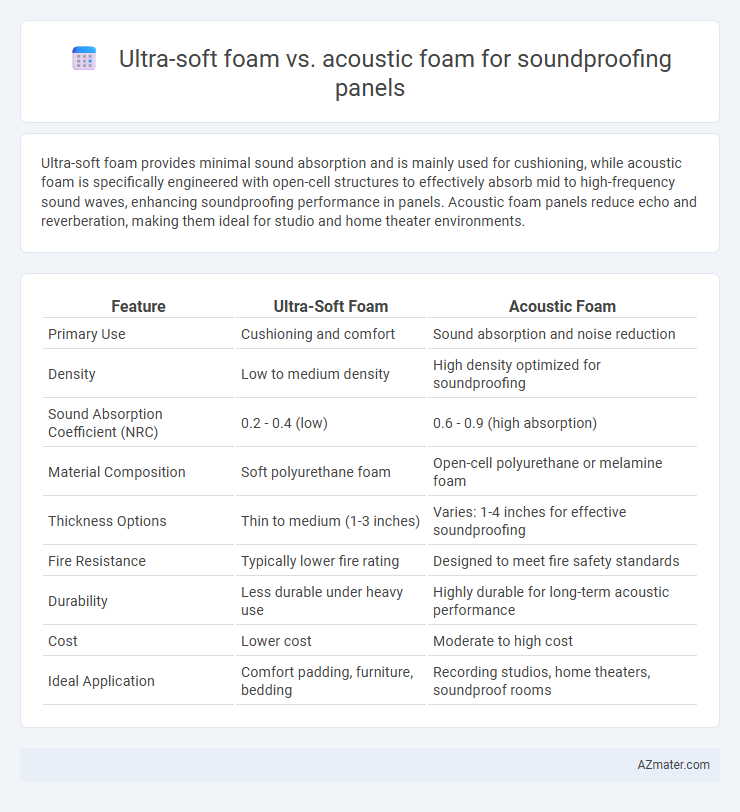Ultra-soft foam provides minimal sound absorption and is mainly used for cushioning, while acoustic foam is specifically engineered with open-cell structures to effectively absorb mid to high-frequency sound waves, enhancing soundproofing performance in panels. Acoustic foam panels reduce echo and reverberation, making them ideal for studio and home theater environments.
Table of Comparison
| Feature | Ultra-Soft Foam | Acoustic Foam |
|---|---|---|
| Primary Use | Cushioning and comfort | Sound absorption and noise reduction |
| Density | Low to medium density | High density optimized for soundproofing |
| Sound Absorption Coefficient (NRC) | 0.2 - 0.4 (low) | 0.6 - 0.9 (high absorption) |
| Material Composition | Soft polyurethane foam | Open-cell polyurethane or melamine foam |
| Thickness Options | Thin to medium (1-3 inches) | Varies: 1-4 inches for effective soundproofing |
| Fire Resistance | Typically lower fire rating | Designed to meet fire safety standards |
| Durability | Less durable under heavy use | Highly durable for long-term acoustic performance |
| Cost | Lower cost | Moderate to high cost |
| Ideal Application | Comfort padding, furniture, bedding | Recording studios, home theaters, soundproof rooms |
Introduction to Soundproofing Panels
Soundproofing panels use materials like ultra-soft foam and acoustic foam to control sound by absorbing and dampening noise. Ultra-soft foam offers superior comfort and flexibility for reducing echo and reverberation in smaller spaces, making it ideal for home studios or offices. Acoustic foam, designed with specialized patterns and densities, effectively traps sound waves to minimize sound transmission and improve overall room acoustics.
What is Ultra-soft Foam?
Ultra-soft foam is a cushioning material characterized by its low density and high compressibility, often used to enhance comfort and minimal sound absorption in soundproofing panels. Acoustic foam, in contrast, is designed with a porous structure to absorb sound waves and reduce echo, making it more effective for soundproofing applications. While ultra-soft foam provides softness and some slight noise dampening, acoustic foam is specifically engineered for superior sound absorption and noise control.
What is Acoustic Foam?
Acoustic foam is a specialized material designed to absorb sound waves and reduce echo within a room, typically made from open-cell polyurethane foam with a distinctive wedge or pyramid shape. It enhances sound quality by minimizing reverberation and controlling mid to high-frequency noise, making it ideal for recording studios, home theaters, and offices. Unlike ultra-soft foam, acoustic foam offers targeted sound absorption and improved durability for effective soundproofing panel applications.
Key Differences in Material Composition
Ultra-soft foam typically consists of low-density polyurethane, designed primarily for comfort and minor sound absorption, whereas acoustic foam is manufactured from high-density melamine or open-cell polyurethane to effectively control sound reflections and reverberations. The porous structure and rigidity of acoustic foam panels enhance their ability to dampen mid to high-frequency sound waves, while ultra-soft foam's dense and pliable texture absorbs less sound and is less effective for true soundproofing. Material composition directly impacts performance; acoustic foam's specialized cellular makeup optimizes sound diffusion and absorption, offering superior acoustic treatment compared to the cushioning properties of ultra-soft foam.
Sound Absorption Capabilities
Ultra-soft foam offers limited sound absorption capabilities, primarily dampening high-frequency noise due to its less dense structure. Acoustic foam, with a denser and open-cell design, excels in absorbing a broader range of sound frequencies, especially mid to high frequencies, reducing echo and reverberation effectively. For optimized soundproofing panels, acoustic foam is preferred as it enhances sound clarity and minimizes noise transmission more efficiently.
Noise Reduction Performance
Ultra-soft foam offers minimal noise reduction performance due to its low density and high porosity, making it ineffective at absorbing mid to high-frequency sounds. Acoustic foam panels, engineered with open-cell structures and varying thicknesses, effectively reduce reverberations and airborne noise by trapping sound waves and preventing echo. For optimal soundproofing, acoustic foam provides superior noise control compared to ultra-soft foam, especially in professional settings requiring clear audio quality.
Durability and Lifespan
Ultra-soft foam panels offer limited durability and tend to compress or deform over time, reducing their effectiveness in soundproofing applications. Acoustic foam, designed with open-cell structures and high-density materials, provides superior lifespan and maintains its sound absorption properties even under prolonged use. Investing in acoustic foam panels ensures long-term performance and resilience against wear, making them a more durable choice for soundproofing needs.
Installation and Maintenance
Ultra-soft foam offers easy installation due to its lightweight and flexible structure, allowing quick attachment with adhesive sprays or simple mounting hardware. Acoustic foam panels typically require precise placement and may need additional support such as frame mounting or specialized adhesives to maintain optimal sound absorption. Maintenance of ultra-soft foam involves minimal effort since it repels dust and resists deformation, while acoustic foam demands regular vacuuming and inspection to preserve its acoustic properties and prevent physical damage.
Cost Comparison
Ultra-soft foam typically costs less per square foot compared to acoustic foam, making it a budget-friendly option for basic sound absorption needs. Acoustic foam, often composed of specialized materials with varying densities and shapes, commands higher prices due to its enhanced performance in isolating and diffusing sound waves. When focusing on cost-effectiveness for soundproofing panels, ultra-soft foam may suit low-budget projects, while acoustic foam offers better value for professional-grade acoustic treatment despite the higher investment.
Choosing the Best Foam for Soundproofing Needs
Ultra-soft foam offers superior comfort and minimal density but lacks the density required for effective soundproofing, making it more suitable for cushioning than acoustic treatment. Acoustic foam, designed with open-cell structures and varying thicknesses, excels in absorbing mid-to-high frequency sound waves, reducing echo and improving room acoustics. Choosing the best foam depends on the specific soundproofing goals, where acoustic foam provides efficient noise reduction while ultra-soft foam favors comfort over sound isolation.

Infographic: Ultra-soft foam vs Acoustic foam for Soundproofing panel
 azmater.com
azmater.com